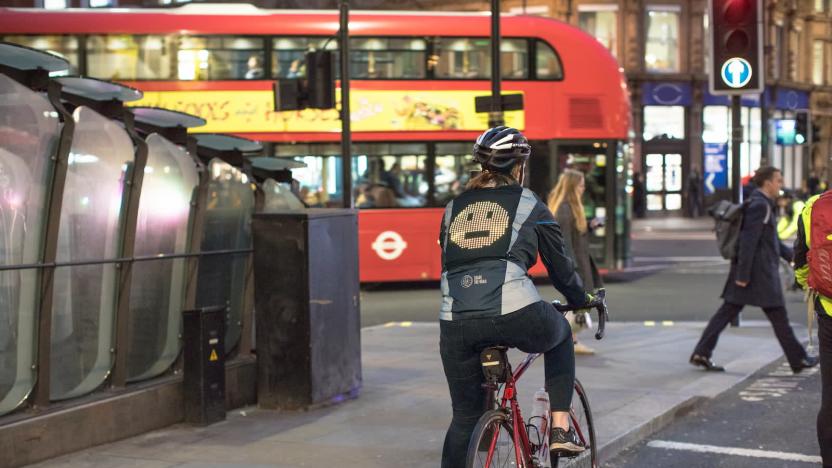road safety
Latest

UK trials roadside van that detects if drivers are holding their phone
The sensor test vehicle can also check whether drivers and passengers are wearing seatbelts.

Ford’s biking jacket shows emoji to everyone behind you
While the number of traffic accident fatalities in the US is thankfully decreasing, there were more cyclist and pedestrian deaths on the roads in 2018, the most recent year for which NHTSA data is available. There were 51 more cyclist deaths that year than in 2017, a rise of 6.3 percent. A recent European Transport Safety Council report, meanwhile, determined that 19,450 cyclists died on EU roads between 2010 and 2018.

How Google's robotic cars deal with human stupidity
Like the Terminator T-800, Google's self-driving cars don't feel pity, remorse or fear. But they also never lose their patience or get distracted by smartphones, and Google has revealed data collected by its vehicles showing just how bad we human drivers can get. It said the goal with the Medium article was to improve road safety by reminding us that "driver error causes 94 percent of crashes." Program director Chris Urmson said that "our safety drivers routinely see people weaving in and out of their lanes; we've spotted people reading books, and even one playing a trumpet."

Scientists investigating AI-based traffic control, so we can only blame the jams on ourselves
Ever found yourself stuck at the lights convinced that whatever is controlling these things is just trying to test your patience, and that you could do a better job? Well, turns out you might -- at least partly -- be right. Researchers at the University of Southampton have just revealed that they are investigating the use of artificial intelligence-based traffic lights, with the hope that it could be used in next-generation road signals. The research uses video games and simulations to assess different traffic control systems, and apparently us humans do a pretty good job. The team at Southampton hope that they will be to emulate this human-like approach with new "machine learning" software. With cars already being tested out with WiFi, mobile connectivity and GPS on board for accident prevention, a system such as this could certainly have a lot of data to tap into. There's no indication as to when we might see a real world trial, but at least we're reminded, for once, that as a race we're not quite able to be replaced by robotic overlords entirely.

Road safety project simTD connects cars, infrastructure. Hopes to save lives, time
Live traffic info likely prevents many a clenched fist meeting steering wheel every single day. A new trial scheme in Frankfurt Germany, however, could prevent even more unnecessary road-rage. The project involves 120 vehicles from a range of manufacturers, loaded with "car-to-x" technology. Cars will communicate with each other, and with general infrastructure, in an attempt to make roads safe and less congested. As well as basic location data, other tools include a brake light that advises the car behind it once activated, and an obstacle warning system to share information on the presence and location of hazards -- as well as what those blockages are. The project is a collaboration between Universities, research institutes, telecom providers -- and of course -- the auto industry. We're keen to see how the trial turns out. Even if it's just to lower our next taxi fare.

BMW presents car-to-x communication, wants vehicles to talk more (video)
What good is an Ultimate Driving Machine if it can't get a little help from its friends? A new hazard-dodging system from BMW could help these Bavarian autos get a bit more chatty, each vehicle talking to nearby traffic across long-range wireless networks. In a series of video demonstrations, the car maker shows how the car-to-x system could give advance warnings of traffic, emergency vehicles and weather hazards by enabling one car to beam warnings directly to others. BMW hopes to connect the system to mobile phone networks as latency times improve and possibly even access data from traffic light systems. Sure, GM and Ford got there a bit earlier, but you can see BMW's implementation demonstrated after the break, and check out the via link for more videos of the world's most boring game of GTA.

GM's new crash test dummies can say 'ouch!' 10,000 times a second
General Motors may have gone through a teeny tiny bankruptcy problem, but that doesn't mean it's behind the times. The American motor maker's just unveiled its latest crash test dummies -- or anthropomorphic testing devices, to give them their highfalutin title -- which are capable of beaming out status reports 10,000 times per second. Equipped with 70 to 80 sensors each, the new family of test devices spans a wide range of potential passengers, from fully grown males to toddlers, though it is slightly disappointing to see they all have washboard abs and perfect posture. Come now, GM, we'd hardly call a race of perfectly sculpted drones that can speak fast enough to converse with a hummingbird representative. Video and the full press release can be found after the break.

IBM seeks patent for intelligent traffic lights
In the great pantheon of things unlikely to happen, this IBM idea ranks pretty highly, but that doesn't necessarily make it a bad one. Big Blue has applied for a patent covering a sophisticated new traffic lights system, which judges how long cars have to wait and sends them ominous-sounding "stop-engine notifications" when the pause is long enough to make switching off optimal. This is done by communicating with queuing vehicles and collecting their positional data, and subsequent start-engine notices are also distributed intelligently, as the first car in the queue gets it earlier than the second and so on right to the back. We don't know how many dudes would abide by the instructions of a lightbox up in the sky, but it's still a neat little concept -- maybe we'll see it in action when hovercars go mainstream. [Thanks, Yuka]

US government launches Distraction.gov, wants to scare you straight (video)
European countries may have long ago banished the use of cellphones while driving to the dark side of the law, but many of the United States persist in allowing their citizens to talk while driving. One reason for their reluctance may be that outlawing something that has become second nature to most people would be both unproductive and tough to enforce. So what do you do? The natural alternative to forcing people to drive attentively is educating them of the reasons why. Never mind the fact that we all kinda, sorta know the risks we undertake while operating a Droid and a Dodge concurrently. The newly minted Distraction.gov is chockfull of scaremongering statistics, topped by a truly epic video which we've handily stashed for you just after the break. Go get it while it's hot.

Art Lebedev's Transparentius eliminates opacity, improves road safety
Kudos where it's due: not many design houses use tanks in their illustrations of a new road safety concept. Transparentius, as with most good ideas, is remarkably simple -- you jack a camera onto the front of a truck, or lorry as they're known in some places, and then project that image onto the back of your hulking transporter. The effect of this is to render the truck figuratively transparent for the driver behind, who is enriched with a lot more information about what lies on the road ahead. No word on how the rear projection is achieved or how sunlight glare is overcome, but knowing Art Lebedev, you can bet both challenges are solved in the most unaffordable fashion possible. Anyhow, now that you've got the idea, we're throwing this one over to you dear mod-loving friends -- can you build this without remortgaging the house? [Thanks, Dennis]

LED traffic lights don't melt snow, do cause accidents
A number of cold weather American states are reporting their dismay at finding out that LED traffic lights are so energy efficient that they do not produce enough excess heat to dissipate any snow that covers them. It turns out, perhaps in an homage to bad engineering everywhere, that the inefficiency of incandescent light bulbs was previously relied upon to keep traffic signals unimpeded. The new LEDs do not achieve the same effect, which has resulted in a few accidents and even a death being blamed on obstructed traffic lights. Feel free to apply palm to face now. It's not all gloomy, though, as the majority of people are said to treat a dysfunctional traffic light as a stop sign (how clever of them), and a tech fix is being worked on as we speak.

MMO teaches kids all about road safety ... by keeping them safely indoors
Edutainment title Code of Everand is the UK Department of Transport's effort to teach children road safety. The free MMO is targeted at 9-13 year olds and attempts to "encourage and reward" repetition of good behaviors for the real world. The premise is actually surprisingly clever, with players taking the role of the Pathfinders and endeavoring to safely cross "the Spirit Channels," which are glowing streams, laid out like roads filled with monsters. On that note, if children from almost any other country play the game, remember to first look left before crossing the Spirit Channels and not right -- that's a free protip. Check out the Everand trailer after the break. [Via Edge]

ATX In-Vehicle Text-by-Voice reduces the subtleties of your chatter to cold, hard SMS
ATX, a major but rarely heard-of telematics supplier, has become the first to offer full handsfree text messaging. While the Ford Sync already allows the sending of pre-canned missives by voice command, this new system transcribes your messages and is fully voice-operated, freeing both hands for driving. Given the forthcoming ban on regular old button mashing, you could probably do worse than grabbing one of these and continuing your bad habits. It won't be easy though, as ATX doesn't offer retrofits and market leader OnStar has said it won't be offering a competing product, leaving you to choose from among the upcoming models by Toyota, Lexus, BMW, Peugeot, Mercedes, Maybach and Rolls-Royce. Maybe we're just jaded, but we'd rather engage in the lost art of talking to people on our good old Gordon Gekko-styled carphone.[Via Dallas Observer]




